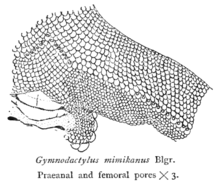
Lizard is the common name used for all squamate reptiles other than snakes, encompassing over 7,000 species, ranging across all continents except Antarctica, as well as most oceanic island chains. The grouping is paraphyletic as some lizards are more closely related to snakes than they are to other lizards. Lizards range in size from chameleons and geckos a few centimeters long to the 3-meter-long Komodo dragon.

The Lacertidae are the family of the wall lizards, true lizards, or sometimes simply lacertas, which are native to Afro-Eurasia. It is a diverse family with at about 360 species in 39 genera. They represent the dominant group of reptiles found in Europe.

Psammodromus is a small genus of sand lizards of the family Lacertidae. It has six described species, which are found in European and North African countries next to the Mediterranean.

Podarcis muralis is a species of lizard with a large distribution in Europe and well-established introduced populations in North America, where it is also called the European wall lizard. It can grow to about 20 cm (7.9 in) in total length. The animal has shown variation in the places it has been introduced to. Fossils have been found in a cave in Greece dating to the early part of the Holocene.
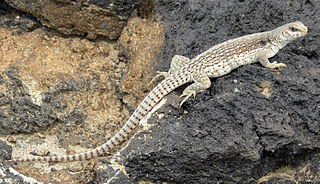
The desert iguana is an iguana species found in the Sonoran and Mojave Deserts of the Southwestern United States and northwestern Mexico, as well as on several Gulf of California islands.

Scent gland are exocrine glands found in most mammals. They produce semi-viscous secretions which contain pheromones and other semiochemical compounds. These odor-messengers indicate information such as status, territorial marking, mood, and sexual behaviour. The odor may be subliminal—not consciously detectable. Though it is not their primary function, the salivary glands may also function as scent glands in some animals.

Toxicofera is a proposed clade of scaled reptiles (squamates) that includes the Serpentes (snakes), Anguimorpha and Iguania. Toxicofera contains about 4,600 species, of extant Squamata. It encompasses all venomous reptile species, as well as numerous related non-venomous species. There is little morphological evidence to support this grouping; however, it has been recovered by all molecular analyses as of 2012.

Takydromus sexlineatus, the Asian grass lizard, six-striped long-tailed grass lizard, or long-tailed grass lizard, is an arboreal, diurnal species of lizard. The tail length is usually over three times the body length in this species.
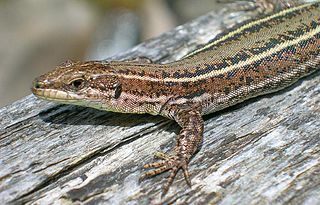
Podarcis hispanicus, also known as Iberian wall lizard, is a small wall lizard species of the genus Podarcis. It is found in the Iberian peninsula, in northwestern Africa and in coastal districts in Languedoc-Roussillon in France. In Spanish, this lizard is commonly called lagartija Ibérica.

The northern Bahamian rock iguana is a species of lizard of the genus Cyclura that is found on Andros Island and the Exuma islands in the Bahamas. Its status on the IUCN Red List is vulnerable, with a wild population of less than 5,000 animals.

Iberolacerta cyreni, commonly known as the Cyren's rock lizard, is a species of lizard in the family Lacertidae. The species is endemic to central Spain and is currently listed as endangered by the IUCN due to global warming. I. cyreni has evolved to exhibit key behavioral characteristics, namely individual recognition, in which a lizard is able to identify another organism of the same species, as well as thermoregulation.

The Iberian worm lizard, Mediterranean worm lizard, or European worm lizard is a species of reptile in the family Blanidae of the clade Amphisbaenia. The Iberian worm lizard is locally known as cobra-cega (Portuguese), culebrilla ciega (Spanish), and colobreta cega (Catalan), all meaning "blind snake". Recent studies into the mitochondrial and nuclear genomic data of 47 isolated B. cinereus populations show rather large sequence divergence between two apparent clades, leading some researchers to call for a division of the Iberian worm lizard into two species. While little is known of B. cinereus in comparison with some other reptile species, new insight is growing about this primitive, ancestral reptile.
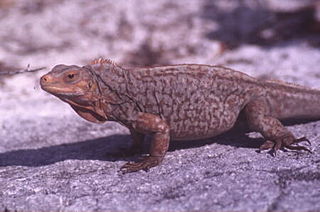
Cyclura rileyi cristata, the White Cay iguana or Sandy Cay rock iguana, is a critically endangered subspecies of lizard of the genus Cyclura native to a single cay in the Bahamas: White Cay located in the Southern Exumas.
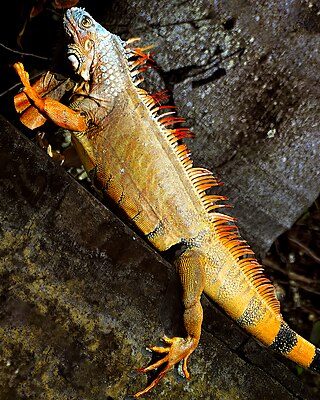
Iguana is a genus of herbivorous lizards that are native to tropical areas of Mexico, Central America, South America, and the Caribbean. The genus was first described in 1768 by Austrian naturalist Josephus Nicolaus Laurenti in his book Specimen Medicum, Exhibens Synopsin Reptilium Emendatam cum Experimentis circa Venena. Three species are placed in the genus: the green iguana, which is widespread throughout its range and a popular pet, the marine iguana and the Lesser Antillean iguana, which is native to the Lesser Antilles. Genetic analysis indicates that the green iguana may comprise a complex of multiple species, some of which have been recently described, but the Reptile Database considers all of these as subspecies of the green iguana.

Bosc's fringe-toed lizard or Bosk's [sic] fringe-fingered lizard is a species of lizard in the family Lacertidae. The species is endemic to North Africa and Western Asia. Three subspecies are sometimes recognised; A. boskianus boskianus, from Lower Egypt; A. boskianus euphraticus from Iraq; and A. boskianus asper from the rest of the range; however this division is unsatisfactory because each subspecies has much variation and the differences between them are not consistent.
Lizards are among the most diverse groups of reptiles with more than 5,600 species. With such diversity in physical and behavioral characteristics, lizards have evolved many different ways to communicate. Lizards communicate to gain information about the individuals around them by paying attention to various characteristics exhibited by individuals and using various physical and behavioral traits to communicate. These traits differ based on the mode of communication being used.

Meroles squamulosa is a species of African lizard originally placed in the genus Ichnotropis, however phylogenetic evidence moves this species to the genus Meroles. The species is commonly called the common rough-scaled lizard or savanna lizard. It is largely found in southern Africa. These lizards are terrestrial and found in the range of mesic savannah. The common rough-scaled lizard is medium in size and well distributed in parts of Namibia, Botswana, Zimbabwe, Angola, Tanzania, and Zambia.

Arthropods, including insects and spiders, make use of smooth adhesive pads as well as hairy pads for climbing and locomotion along non-horizontal surfaces. Both types of pads in insects make use of liquid secretions and are considered 'wet'. Dry adhesive mechanisms primarily rely on Van der Waals' forces and are also used by organisms other than insects. The fluid provides capillary and viscous adhesion and appears to be present in all insect adhesive pads. Little is known about the chemical properties of the adhesive fluids and the ultrastructure of the fluid-producing cells is currently not extensively studied. Additionally, both hairy and smooth types of adhesion have evolved separately numerous times in insects. Few comparative studies between the two types of adhesion mechanisms have been done and there is a lack of information regarding the forces that can be supported by these systems in insects. Additionally, tree frogs and some mammals such as the arboreal possum and bats also make use of smooth adhesive pads. The use of adhesive pads for locomotion across non-horizontal surfaces is a trait that evolved separately in different species, making it an example of convergent evolution. The power of adhesion allows these organisms to be able to climb on almost any substance.

Strophurus williamsi, also known commonly as the eastern spiny-tailed gecko, the soft-spined gecko, and Williams' spiny-tailed gecko, is a species of lizard in the family Diplodactylidae. The species is endemic to semi-arid regions of eastern Australia including Queensland, New South Wales, Victoria and South Australia. It has become a popular species as a pet for its distinctive tail features. S. williamsi has been grouped within a clade of seven other species that are believed to have diverged from their ancestors around 20 million years ago. S. williamsi can be distinguished from closer relatives by arboreality and diurnal (day-active) activity.

The femoral gland is a specialised gland found in some male frogs that plays a role in chemical communication and reproductive signalling. Particularly prominent within the frog family Mantellidae, these glands are located on the underside of the hindlimbs, usually on the inner thighs or shanks. Femoral glands can be identified by their swollen appearance and distinct colouration, which differ from the surrounding skin. Femoral glands are classified into four distinct morphological types, varying from minute granular structures to conspicuous patches characterised by large granules and prominent central indentations.
